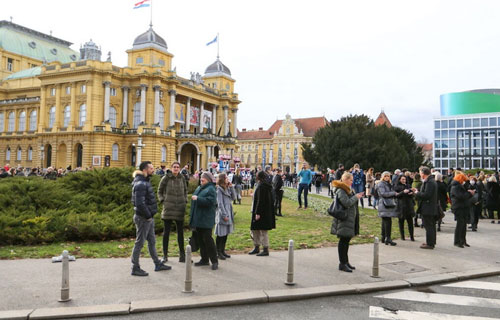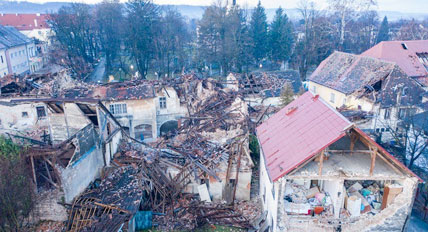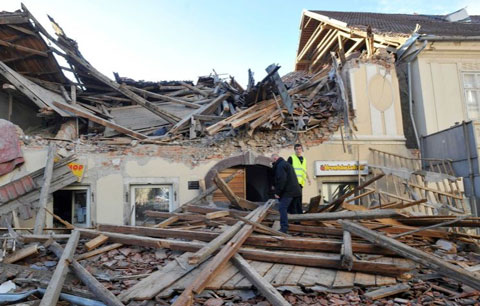A powerful 6.4-magnitude earthquake in Croatia struck on Tuesday, according to the U.S. Geological Survey and Croatian officials. A series of aftershocks, 4.8 and 4.7 magnitudes, then struck at around 06:15 local time on Wednesday, causing further damage to buildings. The fear of potential aftershocks meant many people were too afraid to return to their homes overnight, officials said. Some people slept in their cars or stayed with relatives in other areas. About 200 people sought shelter in a military barracks.
So far, at least seven people were killed and dozens wounded. A 12-year-old girl was killed in Petrinja on Tuesday after being hit by falling debris. Five people died in the nearby town of Glina. State media reported that a seventh victim was found in the rubble of a church in the village of Zazina. Several towns and villages in central Croatia are now in ruins. However, the full extent of casualties remains unknown until emergency crews and the military complete the search and rescue operations.
History of Earthquake in Croatia

An earthquake in Croatia is not an unfamiliar thing these days. Croatia sits on the Split-Karlovac Fault – a major fault line that extends from Split in the south to Karlovac in the north. Earthquakes are common in Croatia but are usually small ones. The last strong earthquake struck in the 1990s and destroyed the picturesque Adriatic coastal village of Ston.
In an earthquake-prone region, a 5.3 magnitude earthquake hit Zagreb in March that rattled residents and caused significant damage to buildings in the city. This one hit just after noon local time, the epicenter, near Petrinja and Sisak, about 30 miles from the capital, Zagreb. However, the US Geological Survey said Tuesday’s was the largest earthquake in Croatia since the introduction of modern seismic instrumentation. The last one of similar size occurred in 1880 near Zagreb. Tuesday’s quake was felt across the Balkans in neighboring Bosnia and as far away as Italy and Hungary. It followed a smaller earthquake the day before.

Rescuers scoured the rubble in dozens of villages near the earthquake epicenter of Petrinja throughout Tuesday night. In a dramatic rescue, a man and a child were pulled from a car buried under debris. Darinko Dumbovic, mayor of Petrinja told local reporters that he did not know the condition of the two but that they appeared to be alive.
Earthquake Devastates Petrinja
On Wednesday, Mayor Dumbovic told state television that “I also heard that the kindergarten collapsed. But fortunately, there were no children [in the building at the time]. This morning we were hit by the third, if not the fourth, earthquake. Everything that has not yet fallen is falling.” Mayor Dumbovic said that about half the town was destroyed. Large parts of Petrinja and the nearby town of Sisak were without electricity early on Wednesday, leaving many residents to seek temporary accommodation – with little prospect of an early return home. Croatia’s prime minister said it was “clear as day” that Petrinja was no longer safe for human habitation.

The earthquake damaged the region’s largest hospital, though it still had to accept the injured for triage until the government could relocate them and 40 coronavirus patients, to other hospitals. Hospital director Tomislav Dujmenovic said when the earthquake struck, a woman was in labor and the procedure moved outside. Both the mother and child are in good health. Mr. Dujmenovic told state TV, “We have nowhere to come to work tomorrow — only the gynecology building remains, where we are currently taking care of the most seriously ill. We have nowhere to go tomorrow.”
Earthquake Rocks Beleaguered Nation
The earthquake in Croatia has left an already beleaguered people in worse shape. The 1990s war in the aftermath of Yugoslavia’s breakup left many scars in Croatia and a rebuilding effort since then. While some E.U countries like Germany have made investments in the country over the years, people have faced much economic hardship from their traditional industries’ decline.
The Red Cross in Croatia described the situation as a “very serious” situation. While promising funds for reconstruction, President Zoran Milanovic compared this week’s earthquake in Croatia o Grozny, the capital of Russia’s Chechnyan republic, which was almost destroyed during a siege 20 years ago.

European Commission Ursula von der Leyen tweeted that she had spoken with Prime Minister Plenković following the disaster added that the E.U. was “ready to support” Croatia. The European Union is preparing to send aid to the region. E.U. crisis management chief Janez Lenarcic visited the area on Wednesday. “At the moment, mostly winter tents, electric heaters, sleeping beds, and sleeping bags are needed, as well as housing containers,” Ms. Lenarcic said on Twitter.
If you like this story, please subscribe and share, if possible
